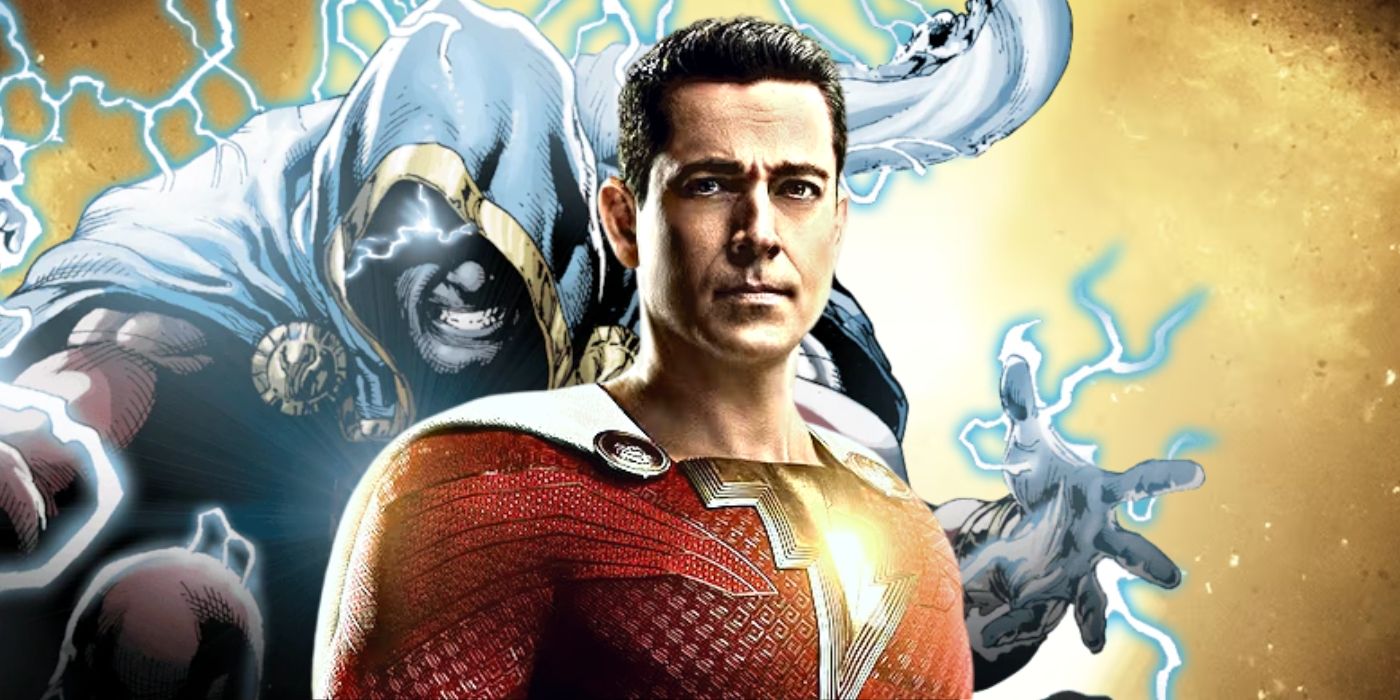The Big Picture
The reveal of Samuel L. Jackson as Nick Fury following the closing credits of Marvel’s Iron Man in 2008, kickstarted a trend in Hollywood. While the post-credit was not a new idea, it became a staple of the Marvel Cinematic Universe and Hollywood blockbusters in general, especially comic book superhero films. Sometimes, Marvel’s post-credit scenes are simply meant to show a gag, reveal a fun cameo, or hint at future installments of a franchise. One of the most useless and unsatisfying post-credit scenes, however, is from Shazam! Fury of the Gods, which is little more than a retread from Shazam!, and proves the post-credit scene from the previous hit was also a waste of time.
Who Is Mister Mind in ‘Shazam!’?
When the original Shazam! movie came out in 2019, the film was a relatively respectable hit, garnering good reviews and drawing respectable, though not spectacular, box office receipts. Audiences generally enjoyed director David F. Sandberg’s take on Big meets superhero movie spectacle. Mark Strong even made for a decent villain as Dr. Thaddeus Sivana, redeeming himself for the disappointing Green Lantern movie from 2011. But the mid-credits scene of Shazam! was the real kicker. The sequence reveals a now imprisoned Sivana trying to rewrite the formula to remember the code to summon the Rock of Eternity. He’s then approached by a sinister, talking caterpillar, who proposes an alliance with Sivana.
Mister Mind is a villain from the original Captain Marvel stories published by Fawcett Comics, not to be confused with Marvel Comics’ multiple heroes and books carrying the name, Captain Marvel. The DC Comics hero known today as Shazam was originally called Captain Marvel. However, due to a lawsuit with Marvel Comics, DC can no longer use that name with the character, so he was renamed Shazam. Mister Mind was first introduced in the 1940s as an evil, hyper-intelligent, telepathic caterpillar, and he’s made recurring appearances over the years as a villain in Shazam’s comic storylines. In the 2019 movie, he’s first seen imprisoned in the Rock of Eternity. It was a cool, surprising Easter egg that Mister Mind appeared in the movie. However, Sandberg took things a step further by actually using the character in the film’s credit scene, potentially setting up a future movie with Mister Mind as the villain. Sandberg also voiced Mister Mind in an uncredited role.
Mister Mind appearing in Shazam! was a very deep cut, especially for such an obscure and odd villain. He’s literally a talking alien caterpillar with sentient intelligence and superpowers. Therefore, using such a character is a rather bold, daring choice, and a modern moviegoing audience might not go along with the idea. It would need to be executed perfectly, similar to characters like Rocket and Groot in Guardians of the Galaxy. That said, Sandberg did such a great job with Shazam!, it appeared he created a world where such a character could potentially work on the big screen. The idea that the movie version of Shazam could potentially face Mister Mind in a future big-screen adventure was exciting. Unfortunately, it was not meant to be.
‘Shazam! Fury of the Gods’ Pays No Mind to Mister Mind’s Post-Credit Scene
When the sequel to Shazam! finally hit theaters, there was no Mister Mind like the previous tease in the first movie. The villains in the second movie were the Daughters of Atlas, a group of Greek goddesses and the daughters of the Titan, Atlas. After they freed themselves from magical imprisonment, Hespera (Helen Mirren), Kalypso (Lucy Liu), and Anthea (Rachel Zegler) sought revenge against the Council of Wizards who stole their powers, which were later inherited by Billy Batson (aka Shazam) and shared with his foster family.
Fury of the Gods is a flawed movie, but one could argue it wasn’t quite as bad as reviews and fans have pegged it out to be. That said, the villains were underwhelming, especially when the first movie teased Mister Mind as a future threat. Not to mention, Black Adam would have been an infinitely more appropriate adversary for Shazam in either of his two films, considering that Black Adam is Shazam’s archenemy from the comics. However, Warner Bros. and Dwayne “The Rock” Johnson were fixated on the idea that they needed to present Black Adam as an antihero starring in his own film. But that’s another issue entirely — Fury of the Gods has a villain problem. The Daughters of Atlas are not very interesting or compelling characters, and there is no payoff to the Mister Mind setup from the first movie.
Mister Mind does make a repeat appearance in Fury of the Gods, but only in the post-credits scene in what is essentially a retread of the first movie. Dr. Sivana is still in the same prison, Mister Mind is back, and Dr. Sivana is justifiably frustrated that he’s waited two years. Mister Mind comedically points out that it takes him a long time to get things because he’s a tiny creature. However, after Mister Mind teases some dastardly secrets, he remembers there’s just “one more thing he needs to do” and crawls away, once again frustrating Dr. Sivana. That was the only payoff to the credit scene in the first movie — all of it was just for a throwaway Looney Tunes type of gag. The idea was never to have Mister Mind appear as a villain, it was simply to use the character in a throwaway joke credit scene, drawing an ultra-realistic conclusion from Mister Mind’s existence. Since Mister Mind is a tiny caterpillar that just crawls around like an insect, it takes him a long time to get to one place from another. The movies never integrate Mister Mind into the main story or show Mister Mind meeting or confronting Shazam.
In Shazam!, Mister Mind’s appearance was rather fun and exciting. He even has a cool line when he says, “I named the gods doctor, not the other way around,” adding, “Oh what fun we’re going to have together. The Seven Realms are about to be ours.” That scene raised fans and audiences expectations for nothing. The rehashed scene in Fury of the Gods suggests that Sandberg didn’t have a true plan for how to use Mister Mind, or maybe he couldn’t figure it out. Perhaps, he never had any intention of using Mister Mind in the main story and simply relegated the character to the credit scenes. Admittedly, Mister Mind would likely be a difficult character to utilize in a film’s main story. Maybe Mister Mind would not have worked if he was the villain in the Shazam! sequel, but the outcome of Fury of the Gods was not a success either.
RELATED: ‘Shazam! Fury of the Gods’ Director David F. Sandberg Discusses the IMAX Experience & VFX Tricks
The Danger of Post-Credits Scenes for Marvel & DC
What happened with Shazam! Fury of the Gods speaks of the danger of major blockbuster films attempting to set up big events or tease things without being able to deliver on them. What Marvel Studios accomplished with the MCU made every studio desire some type of shared cinematic universe. This created a domino effect where blockbuster films became obsessed with franchise-building and sequel-baiting, with lots of mid and post-credit sequences, usually teasing events for the sequel or characters of different franchises meeting each other. Marvel Studios didn’t exactly invent this idea, but they packaged it in a way where it became a key feature in a multibillion dollar film series, and every studio wanted to follow the beat of their drum.
Shazam!, as part of what is called the DC Extended Universe or DCEU, seemed to mimic the Marvel Studios formula with the first movie. Shazam! felt much closer in tone to previous Marvel Studios efforts compared to previous DCEU installments, but it was still an entertaining film that worked relatively well. The Mister Mind credit scene added to the film’s fun, enjoyable flavor. However, the way it paid off in the sequel leaves a sour taste in the mouth. It makes the audience feel cheated to simply rehash a credit scene from the first movie with no payoff.
Comparatively, another post-credit scene that was rather useless and unsatisfying was the appearance of Tom Hardy as Eddie Brock in the post-credit scene for Spider-Man: No Way Home. The previous film, Venom: Let There Be Carnage, was a clunky letdown. The film’s one saving grace was a post-credits scene showing that Eddie Brock and the Venom symbiote were transported to the MCU. The scene teased that a meeting of Eddie Brock/Venom and Spider-Man might happen in No Way Home. That meeting did not take place. Instead, No Way Home shows Eddie/Venom at a bar in the MCU, and then he’s promptly sucked back to his own universe without ever meeting Spider-Man/Peter Parker (Tom Holland), though a piece of the symbiote somehow remained in the MCU. No Way Home delivered audiences a stunning, memorable big-screen adventure for Spidery, so the bait-and-switch gag with Eddie and Venom was not as frustrating as what happened with Mister Mind in the Shazam! franchise.
For another example, it seems that whenever Sony Pictures sticks these credit scenes in their hopeful Spider-Man movie universe franchise efforts, they have high hopes of sequel and franchise building that they fail to accomplish. Case in point is the scene with the Vulture (Michael Keaton) in Morbius. Much like what happened with Shazam!, filmmakers should stop throwing in credit scenes without a serious plan to fulfill them later. It’s significantly off-putting when an aspiring blockbuster franchise relies so heavily on sequel-baiting material to sell the film.
With the DCEU effectively ending since James Gunn and Peter Safran are putting together a new DC Universe under DC Studios, Shazam! Fury of the Gods will now be a sad footnote to the DCEU. The minor subplot with Mister Mind is evocative of how the DCEU generally left audiences as a whole: tons of buildup, tons of big promises, with an underwhelming payoff. It’s sadly appropriate. Regardless, viewers can decide for themselves whether they feel the Mister Mind scene in Fury of the Gods works and enhances the overall experience.
A double dose of teasing that will never come to fruition. Read More

